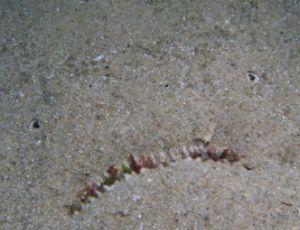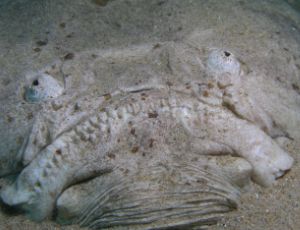|
Michael McFadyen's Scuba Diving - Maccas Reef
While the location of many dive sites are passed on from one diver to another and others are found by searching interesting looking areas, some are found through chances of nature. This is how we found this dive site.
Our plan had been to dive Pizza Reef off Jibbon Bombora at the northern end of Royal National Park. There was a strong southerly wind and large southerly swell running as we located the reef and dropped anchor off the southern end of the small reef. In a short time we hooked in and I checked the depth sounder, sure enough we were in about 21 metres, the right depth. What I did not realise was that the wind was actually a south-westerly so we were pushed in a north-easterly direction, parallel to the edge of the reef. We were not on Pizza Reef, but hooked up on an adjacent reef about 130 metres to the north-east. After the first divers entered the water I looked at the GPS and realised that we were not on Pizza Reef but as the others did not return, I figured that it must have been okay.
We had previously dived another section of this reef (which we called KFC Reef), but this was about 90 metres to the west. As soon as I hit the bottom when my turn came to dive, I realised that this was a better reef than KFC, with much more pronounced walls and huge numbers of fish. I named this site Maccas Reef, not after me, but after McDonalds which, I note, always has outlets next to Pizza Huts and KFC!
To find the site, go out of Port Hacking and turn right once you are past Jibbon Bombora. The GPS mark for the anchoring spot is roughly 34° 04.8945' S 151° 10.8284' E (using WGS84 - if you use any other datum, you will need to convert the reading - see my GPS Page for more details). The site consists of a wall that runs NE-SW near the GPS mark and N-S north of it and E-W south-west of the mark. The depth of the sand is about 27 metres and it is about 21 to 22 metres on the reef top.
As indicated, once you are on the bottom you will find a wall that drops from 22 metres to 24 to 25 metres or so and then slopes to almost 27 metres. This slope has many small boulders and there are a few small gullies into the wall. Follow the wall to the south-west and it is very prominent for about five minutes. The reef breaks into two sections, with a sand patch in between. I would suggest following the deeper section. There are lots of very large sponges, some small gorgonias and many sea squirts along the reef. This is very colourful. As you go, look under the boulders and you may see some Port Jackson sharks and cuttlefish. One the sand there are sea dragons, although not very many.
Once the reef gets a lot flatter, it turns to the right (west) and there are rocks off on the sand to your left. The cave at Pizza Reef is about 30 metres across the sand, due south. If inclined, you can go over and have a look, but you will need good visibility or you may lose your way. This is probably a good spot to turn around, so go back along the way you came, but a little shallower.
Back at the anchor you probably will still have some time so go past the anchor. The wall is again prominent here and after a couple of minutes it turns and runs due north.
 |  |
| What is this under the sand? | A very ugly fish, the stargazer |
On another dive, head north from the anchoring spot. As mentioned in the above paragraph, the wall is prominent and this is probably the better dive. At times it moves five to ten metres away from the actual sand edge and is not as high. There are some small overhangs and cracks. I have seen a couple of very large bullrays here, one without a tail. On the sand I have seen a stargazer. After about 12 minutes the reef edge runs a bit to the east for a little while and then north again. The reef here is a lot flatter on the sand edge, and a smaller wall about 15 metres from the sand. This is about far as you will get before you have to turn around. When returning to the anchor, try following the reef top.
Using scooters, a friend and I continued north from this point for a total of 13 minutes at Speed 1 from the anchor. We estimated that we travelled about 350 metres and this was confirmed by a check with the depth sounder once we got back to the boat. The reef continues north before turning to the west for a short distance and then continuing to the north. Where we turned around the reef appears to turn to the west and run right back towards the Jibbon Bommie. The depth on the sand remained about 27 metres and the reef top 20 metres. The wall is mostly quite prominent but in a couple of spots it is not as high. There is at least one small inlet into the reef, about 20 metres across and 30 metres deep. There is a prominent overhang here as well as some others. There are also some boulders off the wall in spots.
I will put some GPS Marks for other parts of this wall/reef once I have used them and explored that section without scooter.
We also saw a seal on this dive. We have previously seen seals (or the same seal) at Pizza Reef and Jibbon Bombora, so it may be the same one. The fishlife was very prolific on this northern section of the dive, with sweep and one-spot pullers galore.
Back at the anchor, you can go up on the top of the reef and spend a few more minutes before your bottom time is up.
As mentioned above, this is one of the best dives I have ever done in Sydney. The fishlife is prolific, with huge schools of silver sweep, yellowtail, one-spot puller flowing all over the reef and sand edge. As well there are lots of leatherjackets (of many species), some bastard trumpeters, blue morwong, bream and other interesting fish. As I also mentioned, you can see cuttlefish, sea dragons, Port Jackson sharks, eastern blue devilfish and other species here.
A fantastic and little dived spot.
| 
 v6.00.307 © 2003-2005
v6.00.307 © 2003-2005